Implementation of Transportation Management Plans (TMPs) (Presentation)
Printable Version [PPT 4.38 MB]
You will need the Microsoft PowerPoint Viewer to view this PPT file.
Contact Information: WorkZoneFeedback@dot.gov
Slide 1. Implementation of Transportation Management Plans (TMPs)
Presented by Tracy Scriba
Federal Highway Administration
AASHTO Design Meeting
July 15, 2008

Slide 2. Agenda
- Work Zone Safety and Mobility Rule
- TMP Basics
- What Role do Designers Play in Developing TMPs?
- State of the Practice for TMPs
- TMP Development Resources
Slide 3. Work Zone Safety and Mobility Rule
- Published Sept 9, 2004 in Federal Register (69 FR 54562)
- Updates and Renames 23 CFR 630 Subpart J
- Effective Date of Oct 12, 2007
- Establishes requirements and guidelines for consideration and management of WZ impacts
- Requires development and implementation of TMPs for all Federal Aid highway projects (among other things)

Slide 4. TMP Basics: What is a TMP?
A document that lays out a set of coordinated transportation management strategies and describes how they will be used to manage the work zone impacts of a road project

Speaker Notes:
The scope, content, and level of detail of a TMP should vary based on the agency's work zone policy and the anticipated work zone impacts of the project.
Slide 5. TMP Basics: Why TMPs?
- Traffic management efforts beyond temporary traffic control (TTC) plans are needed to deal with the increasing traffic volumes using the same roads on which agencies need to perform maintenance and rehabilitation
- Has affects on:
- Safety
- Mobility
- Constructability
- TMPs = more comprehensive approach to managing WZ impacts
Speaker Notes:
The scope, content, and level of detail of a TMP should vary based on the agency's work zone policy and the anticipated work zone impacts of the project.
Slide 6. Basics: TMP Components
- A TMP may be a single document, or several documents/plans compiled together
- Must always include a Temporary Traffic Control Plan (TTC)
- For significant projects, TMPs must also contain a traffic operations (TO) component and a public information and outreach (PI) component
Simply stated, a significant project is a project that the agency expects will cause a relatively high level of disruption.
Speaker Notes:
If a TMP is several different documents or plans, they should still be coordinated and compiled so that the strategies work together to manage the impacts.
The Rule defines significant project as one that, alone or in combination with other concurrent projects nearby, is anticipated to cause sustained work zone impacts that are greater than what is considered tolerable based on State policy and/or engineering judgment.
All Interstate system projects within the boundaries of a designated Transportation Management Area (TMA) that occupy a location for more than three days with either intermittent or continuous lane closures shall be considered as significant projects.
Slide 7. Basics: When is a TMP Developed?
TMP development should begin during systems planning and progress through design.
- Conducting TMP analyses early in project development helps ensure:
- Systems planning and preliminary engineering: TMP development and implementation costs are included in the project budget
- Design: Agencies consider WZ impacts in evaluation and selection of design alternatives. For some projects it may be possible to choose a design alternative that alleviates many WZ impacts
- Final TMP development occurs during DESIGN
Speaker Notes:
Although a full TMP document is not developed until design, conducting some TMP analyses during systems planning and preliminary engineering will help ensure that the TMP development and implementation costs are included in the project budget. At this early stage, more alternatives for addressing work zone impacts are available, so a broader range of strategies can be chosen. Early TMP development will also help with scheduling and coordinating projects to minimize the cumulative work zone impacts of multiple projects along a corridor or in a region. This includes examining the adequacy of detour or alternate routes and coordinating with the agencies responsible for those routes.
Another strategy available in the earlier stages of project development is to consider work zone impacts in the evaluation and selection of design alternatives. For some projects it may be possible to choose a design alternative that alleviates many work zone impacts.
These broader strategies cross various disciplines and highlight the need for a multidisciplinary approach.
Of Course: Through Value Engineering or Pre-Construction meeting, changes in the project plans could occur that mean adjustments to the TMP are needed.
Slide 8. TMP Development Process
(from Developing and Implementing TMPs for Work Zones)
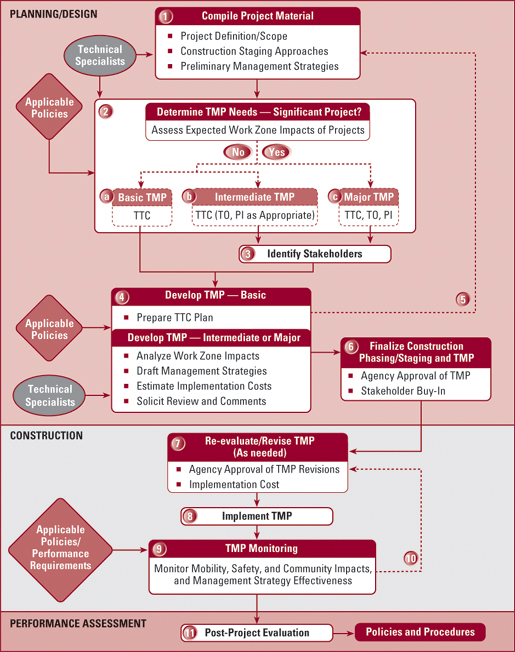
Speaker Notes:
This a general TMP development process diagram that may be used as a starting point for agencies to consider when developing TMP procedures and TMPs for specific projects. The example process in this figure shows three types of TMPs (Basic, Intermediate, and Major). Agencies may elect to develop a different number of categories of TMPs than what is described here.
Slide 9. What Role do Designers Play in Developing TMPs?
Slide 10. During Design…
- Final assessment of WZ impacts is done, which should affect the choice of:
- Best construction/staging option(s)
- Most suitable design and contracting approach
- Most appropriate WZ traffic management strategies
Speaker Notes:
Design-level work zone impacts assessment may include consideration of corridor and network level impacts, coordination with other projects, addressing work zone impacts issues in conjunction with the project design and construction approaches, work zone transportation management, and development of TMPs.
Slide 11. TMP Strategies to Manage WZ Impacts
- Designers are encouraged to consider these strategies early on in the process for all projects, even if they aren't included in the TMP

Speaker Notes:
Traffic Control Approaches
IA1. Construction phasing/staging
IA2. Full roadway closures
IA3. Lane shifts or closures
Reduced lane widths to maintain number of lanes (constriction)
Lane closures to provide worker safety
Reduced shoulder width to maintain number of lanes
Shoulder closures to provide worker safety
Lane shift to shoulder/median to maintain number of lanes
IA4. One-lane, two-way operation
IA5. Two-way traffic on one side of divided facility (crossover)
IA6. Reversible lanes
IA7. Ramp closures/relocation
IA8. Freeway-to-freeway interchange closures
IA9. Night work
IA10. Weekend work
IA11. Work hour restrictions for peak travel
IA12. Pedestrian/bicycle access improvements
IA13. Business access improvements
IA14. Off-site detours/use of alternate routes
Slide 12. Traffic Control/Design Approaches
- Construction phasing/staging
- Night work
- Weekend work
- Work hour restrictions for peak travel
- Full roadway closures
- Lane shifts or closures
- Reduced lane widths to maintain # of lanes
- Lane closures to provide worker safety
- Reduced shoulder width to maintain # of lanes
- Shoulder closures to provide worker safety
- Lane shift to shoulder/median to maintain # of lanes
- One-lane, two-way operation
- Two-way traffic on one side of divided facility (crossover)
- Reversible lanes
- Ramp closures/relocation
- Freeway-to-freeway interchange closures
- Pedestrian/bicycle access improvements
- Business access improvements
- Off-site detours/use of alternate routes
Slide 13. Identification of TMP Strategies
- Should be based on:
- project constraints
- construction phasing/staging plan
- type of work zone
- anticipated WZ impacts
- Some agencies use strict lane closure policies/strategies or permissible lane closure times that must be followed
- Agencies may use analysis tools to predict delays, queues, and impacts of detours and compare these for various strategies
Slide 14. Decisions During Design Impact TMPs
- Design-level decisions can influence the choice of WZ management strategies
- As specific decisions are made, WZ management strategies should also be reassessed to determine if they still apply and whether they adequately mitigate the WZ impacts of the project
Example: Preliminary engineering assessments may result in the identification of 2 alternate "construction and WZ management approaches" – 1) night work with a basic TMP, and 2) daytime work option with a more complex TMP. As design progresses, more information may become available on the feasibility of each of the approaches, leading to the elimination of the night work option. Therefore, the day option would be chosen and TMP strategies such as signal retiming and a traffic incident management plan might be used.
Speaker Notes:
Quantitative Analysis during Design can help determine and design the specific aspects of the management strategies.
- TTC Plan – quantify expected queue length and incorporate that information in designing the taper for the project; design the lane-widths; set the work zone speed limits; estimate costs of TTC strategies; etc.
- TO Component – determine the communications and detector requirements for a work zone traffic monitoring and incident management system; estimate traffic diversion patterns and rates to determine potential impacts on the alternate route(es) and appropriately improve operations on the alternate route (e.g., signal timing adjustments); evaluate the positioning of dynamic message signs (DMS) which may affect the diversion patterns; estimate the number of people who would switch to transit so as to structure the transit incentive program; estimate the costs of the TO strategies; etc.
- PI Component – estimate the volume of traffic that would be affected by the project to determine the PI needs; determine the types of PI strategies to use (e.g., real-time updates through email, telephone based information); coordinate with stakeholders to initiate the PI program; estimate the costs of the PI strategies; etc.
Slide 15. Decisions During Design Impact TMPs
- Detailed quantitative analysis during design may be the best way to get a clear understanding of the expected WZ impacts of a project
- Most project decisions are finalized during design as the project design/construction team gains the best understanding of how exactly the project will be built
A quantitative analysis conducted during design can:
- Yield the best estimation of the magnitude, location, duration, and costs of the WZ impacts
- Help identify the management strategies that best mitigate the impacts
- Help avoid omission or oversight of WZ safety and mobility issues prior to final design
- Help identify and address issues that may lead to a work stoppage during the construction stage (e.g., queue lengths or delays in excess of agency policy)
Slide 16. Decisions During Design Impact TMPs
- During detailed design, quantitative analysis is more detailed and will lead to the development of the final design and TMP for the project
Example: Early WZ impacts analysis done during preliminary engineering using a sketch-planning tool may indicate that traffic diversion to the designated alternate route for the project would be significant, leading to a preliminary decision to upgrade and re-time the traffic signals on the alternate route.
In design a more detailed analysis using a micro-simulation tool is conducted to estimate actual diversion patterns, the volume of traffic expected to divert to the alternate, and the intersections that would be affected. This analysis may then be used to identify the number of traffic signals that need to be upgraded and the exact nature of the upgrades, and to develop the signal timing plans and estimate the costs.
Slide 17. Caltrans I-15 Devore PCCP Reconstruction: Closure Schedule, Cost, Delay Comparison

Speaker Notes:
From this analysis, the design options can be narrowed to two options: the series of 8 72-hour weekday closures, and the option for completely closing one side of the roadbed at a time to do the work. Both of these options have the least cost and total user delay that is not significantly greater than the repeated nighttime closures. Other factors such as other work going on in the area, the schedule for special events, etc could make one of these two options preferred.
For this fast-track pavement reconstruction on Interstate-15 (I-15) at Devore, based on the analysis Caltrans selected the option for two one-roadbed continuous (about 210 hours) closures with round-the-clock (24/7) operations. The integrated analysis concluded that the one-roadbed continuous closures were the most economical scenario when compared to traditional nighttime or weekend closures from the perspective of schedule, delay, and costs. The pre-construction was validated with as-built construction and traffic performances monitored during construction. The construction management plan – including contingency, incentives, and CPM schedule – was developed utilizing the Construction Analysis for Pavement Rehabilitation Strategies (CA4PRS) computer model.
The results of this planning study are useful for transportation agencies in developing highway rehabilitation strategies that balance the maximization of construction productivity with a minimization of traffic delay.
Slide 18. TMP State of the Practice
Slide 19. TMP Beginnings
- Idea for TMP provision in WZ Rule came from Caltrans
- Caltrans began requiring TMPs in 2000 for all planned activities on the State highway system
- Implementation of TMPs in California has helped to significantly reduce delays in work zones
In Caltrans District 7, on the I-10 Long-Life Pavement Project, the TMP helped reduce traffic demand by an estimated 57 percent, queue lengths to 2 miles from the originally projected 44 miles, and projected delays from an estimated 1,000,000 to 16,000 total vehicle hours of delay.
Slide 20. TMP Findings – 2007 WZ Self Assessment
- TMPs are still a developing area
- Has the agency established a policy for the development of TMPs to reduce WZ congestion and crashes?
- Average score for this item increased by 14% in 2006 and by 20% in 2007
- Average score was 8.5, indicating agencies are in the execution stage of adopting TMPs into their WZ practices
- Two-thirds (67%) of agencies are implementing a policy for developing TMPs
Speaker Notes:
The next few slides provide some examples of what various state agencies are doing with regard to TMP development. This is not an all-inclusive list of examples.
Slide 21. Caltrans TMP Fact Sheet
- Provides information about Caltrans TMP Development Process
- Discusses TMP categories, roles and responsibilities, and lessons learned for Caltrans


Slide 22. Caltrans TMP Development Process


Speaker Notes:
This slide illustrates the Caltrans TMP Development process, as described by Jacqueline Ghezzi, P.E., Chief, Traffic Management Branch, Division of Traffic Operations, California Department of Transportation, during a webcast held in February 2005.
- Concept:
- Traffic plans may or may not be built into project specifications and be a part of the bid process. If they are built in, money for contingencies are a part of the bid; otherwise, money is set-aside and contingencies later cause change orders.
- In districts where Project Design and Transportation Management Planning are under the same Senior, traffic plans are conceptually developed during the design process, and there may be up to 20 traffic related meetings before a bid. In other districts, traffic plans are conceptually developed later in the process, and the traffic meetings begin after the bidding process. In either case, traffic plans depend upon specifications and specifications depend upon traffic plans and both are subject to unforeseen events. Which means that flexibility in the event is mandatory, and there must be some concept of strategy and estimate of cost, including provisions for contingencies, from the beginning.
- Kind of TMP:
- Project programming generates a request for a TMP Data Sheet. The first decision, made by Traffic Planning staff, is the type of TMP that will be required: blanket, minor, or major.
- Blanket – If the type of work is "blanket," then staff prepares a brief TMP, issues permits, and the process ends here.
- Minor – If the type of work is "minor," then a formal TMP team is not created, but communications begin among interested parties using the Lane Closure System, and meetings occur as needed during the work zone event.
- Major – If the type of work is "major", then a formal TMP team is created with representatives from Traffic Operations, Design, Engineering Services, Construction, and the California Highway Patrol. If bidding has already occurred, a Contractor representative is also named; otherwise the Contractor representative joins later.
- Prepare Data Sheet:
- A Data Sheet is prepared for all projects. It includes a work description, lists the work areas, and provides available information about traffic patterns and levels.
- Prepare Initial TMP: Since the TMP assumes all participants in planning and implementation are aware of rules contained in the federal MUTCD and California Supplement, it can use shorthand statements and assume, for example, that only approved lane delineation devices will be used in only an approved manner. An actual TMP may be two or two hundred pages. It outlines usage of traffic management strategies and how contingencies are to be handled.
- Funding: The Transportation Management Plan for a project becomes part of the Programming Document for the project. Since a TMP can easily cost several million dollars on a major project, it is a major element either in a bid or in negotiations after a bid.
- Refine:
- Review and modification of construction alternatives and traffic plans occur before and during the course of minor and major projects, often on a daily basis. Usually the two interact, as when unexpected traffic volumes make night work necessary or weather changes cure times or any of many other situational variables change.
- Monitoring a project is particularly important, for many reasons – traffic data is often stale, closures may be sloppy or non-conforming, and enforcement strategies may need to be modified for unanticipated events.
- It is at this stage that cooperation among all involved becomes important, and safety and cost considerations get hammered out in daily actions. Some daily realities are understood, but not formally voiced, as when a Field Engineer can save a Contractor many thousands of dollars on a particular day by extending a closure an hour or so. Others considerations are formal, as when a Contractor proposes saving months on a job by changing the TMP to allow weekend full closures.
- End of Project:
- Important elements of any project are the TMP post-closure evaluation statement and negotiation of change orders and/or performance incentives/disincentives. And the two are related.
- Often the Evaluation Statements exceed the TMP in length and scope, because in any process this complex, the ability to learn over time and adapt to situational variables is crucial to improving the process.
Slide 23. Caltrans TMP Levels


Speaker Notes:
Caltrans TMPs are categorized into three types based on project characteristics and projected delay: Blanket TMP, Minor TMP, and Major TMP. This slide lists the types of conditions and possible strategies for each of these three TMP categories. A Blanket TMP is a standard set of actions taken to minimize delay when performing maintenance activities or projects. Minor TMPs are used for improvement projects when minimal impacts are expected (e.g., night-time construction). Major TMPs are implemented for projects where significant traffic impacts are anticipated and multiple TMP strategies are required to manage impacts.
Caltrans places TMP strategies into 6 categories:
- Public information
- Motorist information
- Incident management
- Construction strategies
- Demand management
- Alternate routes
Slide 24. What Worked for Caltrans?
- Encourage design and project staging that minimizes potential traffic impacts
- Have District Traffic Manager and TMP Manager sign off on TMP just prior to bid to make sure strategies reflect current traffic conditions – especially for "shelved" projects
- Produce standardized forms for blanket and minor projects
- Produce a brief, standardized report for each major project
- Standardize practices for monitoring the effectiveness of TMPs in the field

Slide 25. Missouri DOT TMP Strategies Database
The TMP Database is meant to be used at the very beginning of WZ planning to choose the most effective methods from the start, with re-evaluation occurring in the design stage.

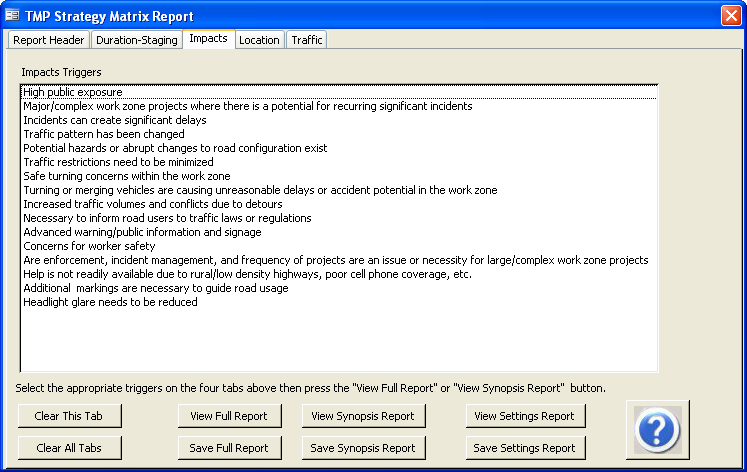
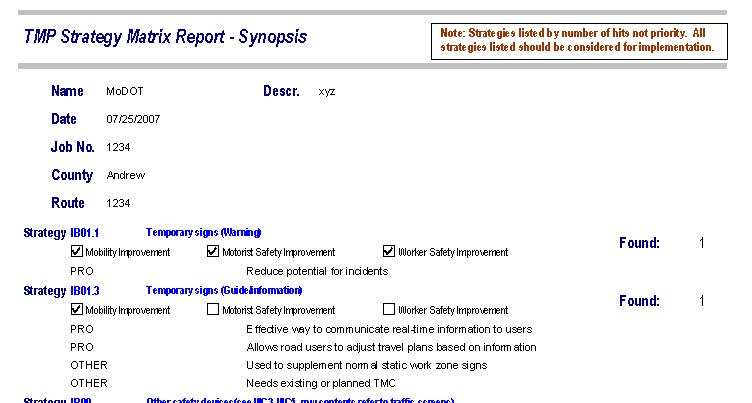
Speaker Notes:
- Missouri DOT has developed a Transportation Management Plan (TMP) Strategy Database to aid in the selection of work zone management strategies and development of TMPs for its road projects in a more systematic way.
- The TMP Strategy Database is an Access database that returns possible appropriate work zone management strategies based on user inputs.
- The database is organized around four major triggers (project goals) focusing on time concerns, public impact, location, and traffic flow.
- Under each area, users can select options such as "short-term project" or "concerns for worker safety" and the system will then display the possible strategies that will meet the goals of each project. The strategies are accompanied by additional pertinent information, such as whether increased enforcement or public information is needed.
- MoDOT said it intends to use the TMP Database at the very beginning of work zone planning in order to choose the most effective methods from the start, with re-evaluation occurring in the design stage. Construction personnel will also be able to use the program to find a solution if concerns arise while the work zone is in operation.
- The database was developed by the Work Zone Quality Circle, MoDOT's work zone management task force, and is based on the work zone management strategies matrix found in the FHWA-developed guide entitled Developing and Implementing Transportation Management Plans for Work Zones Guidebook.
Slide 26. Virginia TMP Requirements
- VDOT has extended TMP requirements to all WZ activities within State right of way and on all streets and highways that have been accepted into the State Highway System – regardless of funding source
- VDOT TMP Guide:
- Provides guidelines for acquiring the information to develop TMPs
- Contains guidance on each Project Team member's role and responsibilities in the development of TMPs
- Applies to Project Managers, Roadway Designers, Traffic Engineers, WZ Safety Coordinators, Public Affairs Managers


Speaker Notes:
The Virginia DOT has developed a document outlining TMP development requirements for all projects. This document provides guidelines to be used by Project Managers, Roadway Designers, Traffic Engineers, Work Zone Safety Coordinators, and Public Affairs Managers pertaining to acquiring the information to develop TMPs. It also contains guidance on each Project Team member's role and responsibilities in the development of TMPs, and guidance to Project Managers on VDOT's TMP requirements based on the project's level of complexity.
The slide shows one of VDOT's TMPs, developed for a major Interstate interchange project on the Capital Beltway.
Slide 27. Virginia TMPs – Design Role
The Roadway Designer:
- Preliminary Field Inspection
- Incorporates the recommended TMP into the project's initial roadway plans
- Public Hearing Meeting
- Incorporates all recommendations/corrections into the preliminary TMP prior to the Public Hearing
- Field Inspection Meeting
- Completes TMP for review by Project Team during the Constructability Review stage for the Detail Roadway Design and Roadway Design phases of Concurrent Engineering Process (CEP)
- Incorporates into the TMP all accepted recommendations/corrections submitted by Project Team
- Pre-Advertisement Conference
- Completes final TMP for review by Constructability Review Team during Constructability and Bidability Review stage of CEP
- Incorporates all recommendations/corrections submitted by Project Team into final TMP prior to proceeding to the next phase

Speaker Notes:
The VDOT TMP Requirements include guidelines to be used by Project Managers, Roadway Designers, Traffic Engineers, Work Zone Safety Coordinators and Public Affairs Managers pertaining to acquiring the information to develop TMPs. The Requirements describes the project team roles during:
- Scoping meeting
- Preliminary Field Inspection
- Public Hearing Meeting
- Pre-Advertisement Conference
- Implementing the TMP
- Evaluating the TMP
Designers are involved in the preliminary field inspection, public hearing meeting, field inspection meeting, and pre-advertisement conference.
Slide 28. Pennsylvania Sample TMP
- PennDOT includes a sample TMP in its Traffic Engineering Manual

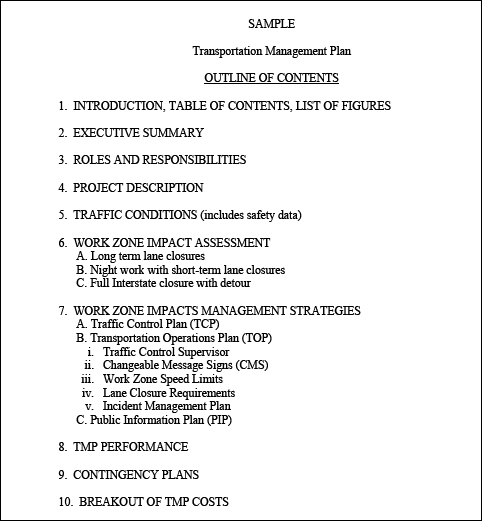
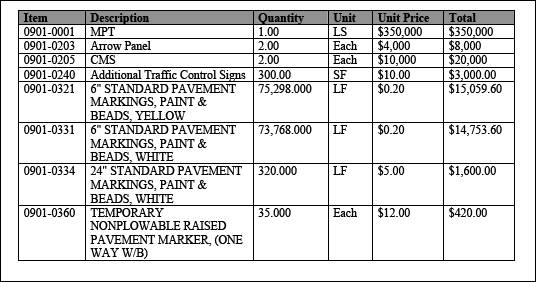
Speaker Notes:
The Pennsylvania Department of Transportation (PennDOT) includes a sample TMP in its Traffic Engineering Manual. This TMP was created for a project on a rural interstate highway with low traffic impacts and was drafted using information that is readily available from other sources.
The sample TMP contains sections for:
- Roles and responsibilities,
- Project description,
- Traffic conditions (includes safety data),
- WZ impacts assessment,
- WZ impacts management strategies (to include a traffic control plan, traffic operations plan, and public information plan),
- TMP performance,
- Contingency plans, and
- A breakout of TMP costs.
It is meant to be expanded as needed depending on the size and complexity of the project.
Slide 29. Wisconsin TMP Process
- Process
- Work Zone Impacts Assessment
- Determine Type of TMP
- Prepare Initial TMP Update, Implement, Monitor
- Evaluate After Project

Speaker Notes:
Wisconsin Department of Transportation has published guidance on development for Work Zone Transportation Management Plans. Responsible parties in the WisDOT TMP process include:
- FHWA
- Bureau of Highway Operations
- Bureau of Project Development
- Regional WisDOT Offices
- Project Development Chief
- Operations Chief
- Regional Planners
- Regional Traffic Engineers
- Project Managers
- Project Designer
- Contractor
- Law Enforcement
- Other Stakeholders
The process is related to the type of project and requires different levels of effort but it may change and be refined with collective experience.
Performing Work Zone Impacts analyses early and later in the process is critical to TMP development.
Impact analysis branches into several disciplines for analysis.
Slide 30. Wisconsin TMP Components
- Type 1
- Traffic Control Plan
- Public Information and Outreach
- Type 2, 3, 4
- Traffic Control Plan
- Public Information and Outreach
- Transportation Operations
- Incident Management
Speaker Notes:
The potential elements of a Wisconsin TMP are:
- Traffic Control Plan
- Public Information and Outreach
- Incident Management
- Transportation Operations
These elements together form the Wisconsin TMP, and are either all developed as one document or can be separate documents compiled together.
Slide 31. When are TMPs developed in Wisconsin?

Speaker Notes:
This is a time line for WiscDOT's typical project development process. They recommend that TMP development begin at Program Level scoping.
WiscDOT and the FHWA Wisconsin Division have developed a one-day course on Wisconsin's TMP Development Process and conducted TMP training in Wisconsin.
Slide 32. North Dakota TMP Development
- NDDOT has TMP development guidelines in its WZ policy
- For significant projects, NDDOT compiles a TMP team to develop and implement the TMP
- Has members from Planning and Programming Division, Maintenance and Engineering Services Division, Construction Services Division, Design Division, District, FHWA, local municipality, and others as necessary
- For non-significant projects:
- Reconstruction project – the Project Designer, Design Division, and District will develop the TMP
- Other than reconstruction projects – Project Designer will consult with Design Division and District

Speaker Notes:
For significant projects:
The TMP will be an ongoing process from the scoping process through the construction process. Pavement Management and Scoping Section will suggest alternate routes and additional studies required for the TMP. Once a project has been incorporated into the STIP a milestone activity will be used to identify when the TMP team will need to begin, which in general will be before the environmental document.
The district shall take the lead and develop a TMP team consisting of members from Planning and Programming Division, Maintenance and Engineering Services Division, Construction Services Division, Design Division, District, FHWA, local municipality, and others as necessary. The TMP team shall review the Work Zone Assessment and Management Procedures, Chapter 1 in regards to goals and recommendations to implement in the TMP. The TMP team shall address the TMP strategies and identify general concepts to be identified in the Environmental Document.
For non-significant projects:
TMP will consist of a TTC plan and consideration should be given to a TO component and a PI component. If the non-significant project is a reconstruction project, the project designer, Design Division and the District will develop the TMP strategies. Projects other than reconstruction projects, project designer will consult with Design Division and the District. The TMP will address level and strategies prior to and shall be identified in the Environmental Document.
Slide 33. Considerations
- Agency WZ policies
- E.g., Maximum WZ queue lengths/delays allowed
- Lane Closure policies/charts that specify when a lane closure is permitted
- Analytical/modeling tools used by the agency
Speaker Notes:
Lane closure policies/charts
- Some state transportation agencies have developed lane closure policies, or strategies, that they use as guidance in determining daily permitted lane closure times.
- Permitted lane closure times define what times of the day, week, or season a lane closure is allowed on a facility and at a specific location or segment.
Slide 34. Colorado Region 6 Lane Closure Strategy
Scenario: State Highway 121 (Wadsworth Boulevard), Northbound Direction, Milepoint 22.0, weekday.
Solution: Referring to the Decision Tree, Wadsworth is an arterial facility. Following the right side of the chart, the appropriate schedule may be found in the table.
Look up SH 121 in the left-most column and locate MP 22.0 between 84th Avenue and 100th Avenue. The weekday schedule indicates that a lane may be closed at night between 7:00pm and 8:00am and during the midday between 10:00am and 2:00pm.
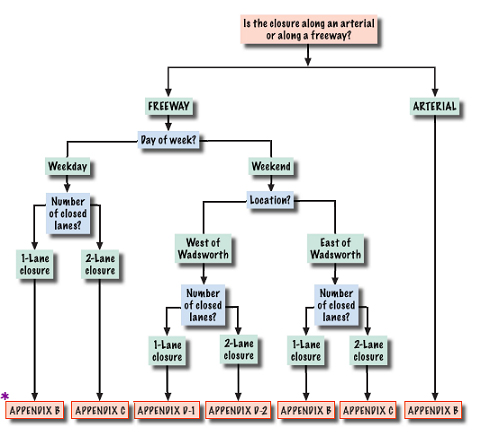

Speaker Notes:
Each Colorado DOT (CDOT) region has its own lane closure policy. While the CDOT methodology used to analyze the roads to determine lane closure impacts is applied uniformly across all regions, the criteria and policies for closing lanes are region specific. For example, daytime lane closures are prohibited in the Denver Metro area, while they are allowed on the more rural sections of I-25.
Slide 35. TMP Development Resources
Slide 36. Tips for Developing TMPs
- Estimate and budget for TMP development and implementation early in project development (update as appropriate throughout project)
- Include funding for monitoring traffic conditions during construction to track TMP effectiveness in case strategies need to be modified and for future WZs
- Consider and address WZ impacts from a broader transportation management perspective, rather than solely a traffic control perspective
- Balance constructability and construction staging requirements with WZ management strategies
- Coordinate phasing/staging with other strategies in TMP (TTC, TO, and PI plans)
- Coordinate with other key parties to jointly identify WZ impacts issues to account for and management strategies to address them
- Preliminary engineering – Design team should work with other technical specialists, including construction, traffic engineering, and public outreach/relations personnel
- Designers/construction engineers – Develop phasing and staging plans in consultation with safety experts, traffic engineers, other technical specialists
- Construction – Maintain close coordination with local agencies on detours and signal timings
Speaker Notes:
A number of these tips come from Caltrans, based on their years of experience with TMPs, and from a few other DOTs we also spoke do while developing our FHWA TMP Guide.
Cost is often a constraint to what strategies are included in a given TMP, particularly for major TMPs. The goal should be to look for work zone management strategies that are likely to be effective for managing impacts, given the project-specific characteristics – with reasonable consideration given to cost.
Slide 37. Tips for Developing TMPs (cont.)
- Use strategies that keep lanes open, especially during peak traffic times
- E.g., narrowing lanes or using shoulders to maintain number of lanes; contract incentives/disincentives; lane rental; damages for late lane opening; night work
- Use "Triggers" – e.g. when 75% of max delay is approached, lane(s) are opened to accommodate traffic
- Consider using extended closures or full closures versus numerous night closures
- Use strategies that facilitate decision-making by the public to avoid the WZ (e.g., public awareness, advance signage in locations prior to key motorist decision points) – these tend to be highly effective
- Update the TMP, as needed, throughout project development and implementation
- TMP training is important for all divisions involved in TMPs
- Management support is needed for effective TMP efforts
Slide 38. TMP Resources
- Caltrans TMP Resources Web Site – http://www.workzones.ucdavis.edu/index.php?title=TMPMain
- Fact Sheet: Caltrans TMPs Reduce WZ Congestion – http://www.ops.fhwa.dot.gov/wz/practices/factsheets/factsheet11.htm
- Virginia DOT TMP Requirements [PDF 217KB]
- Missouri DOT TMP Strategy Database – [MDB 1.2MB]
- Presentation on California's TMP Development Process [PPT 4.7MB]
- Presentation on Virginia's TMP Development Guidelines [PPT 375KB]
Slide 39. TMP Resources
- WZ Safety and Mobility Rule Web Site – http://www.ops.fhwa.dot.gov/wz/resources/final_rule.htm
- Contains sample TMPs, presentations, and TMP development resources
- Developing and Implementing TMPs for Work Zones – http://www.ops.fhwa.dot.gov/wz/resources/publications/trans_mgmt_plans/index.htm
- Contains a TMP Checklist and matrix of TMP strategies
- Advanced Work Zone Management and Design Course (NHI) – http://ops.fhwa.dot.gov/wz/outreach/nhi_wz_courses.htm

To view PDF files, you need the Adobe Reader.
To view Microsoft Access files, you need the Snapshot Viewer.